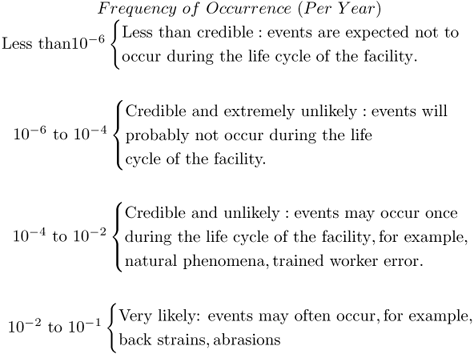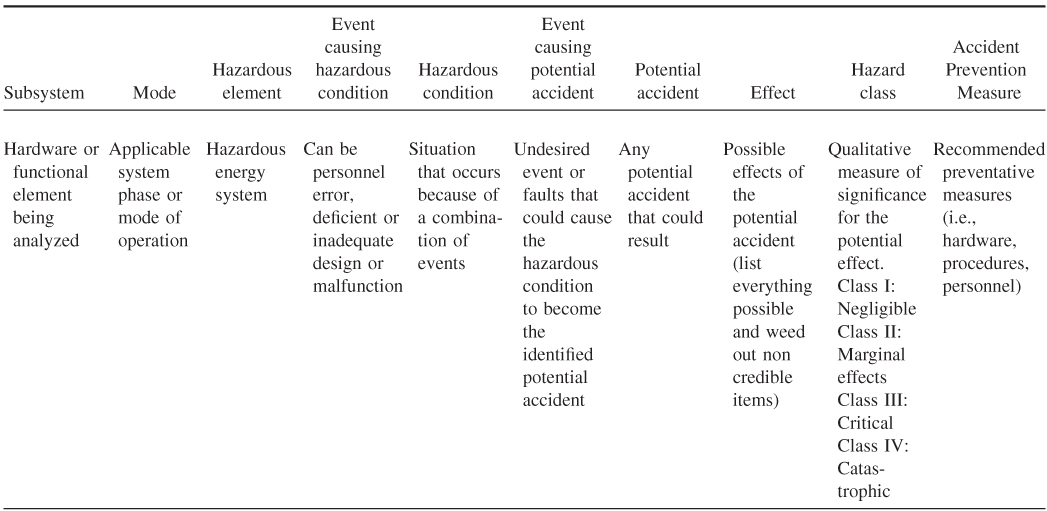6.1 Description
The PHA technique was developed by the US Army and is listed in the US Military Standard System Safety Program Requirements (2). PHAs have been proven to be cost effective in identifying hazards in the beginning of a conceptual design phase. Because of its military legacy, the PHA technique is sometimes used to review process areas where energy can be released in an uncontrolled manner.
The main purpose of a PHA is to identify the hazardous states of a system and its implications. In order to obtain maximum benefit of a PHA, it should occur as early as possible in the system's life cycle. Tasks and requirements involved in preparing a PHA should include the following:
- Establish for purpose of the analysis
- boundaries between the system, any system with which it interacts, and the domain;
- overall system structure and functionality.
- Identify
- detailed list of hazards of the system based on preliminary hazards list report and the requirements;
- update hazards list;
- accidents to the most practicable extent;
- events of accident sequence and those that can be discounted;
- record in hazards list.
- Assign
- each accident a severity categorization and each accident sequence a predicted qualitative/quantitative probability;
- each hazard a preliminary random and systematic probability target.
- Document
- any safety features that are to be implemented during the design and development phase.
6.1.1 Process of Preliminary Hazards Analysis
Hazard analysis is usually performed during the early stages of design, but it can also take place during different stages in the life cycle of processes and facilities.
- For new processes and facilities, at the conceptual (work) design phase, PHAs are performed to identify opportunities to eliminate or reduce hazards. This is done before resources are committed to engineering design and construction.
- During engineering design and construction, design hazards analyses are performed to identify needed system changes or process controls not identified at the conceptual design phase.
- Before initial start-up of a new system or process, prestart-up, operational readiness reviews are conducted to ensure that systems are in place to control all identified hazards.
- Process hazards analyses are conducted periodically during the lifetime of operating facilities/processes, and every time a process/facility undergoes significant modification. This is done to identify any new hazards that may have occurred from a process change and also to ensure that all hazards are adequately controlled.
- When dealing with the decontamination and decommissioning (D&D) and environmental restoration projects, hazard characterizations are conducted to characterize hazards and, when possible, to develop and define prioritized rankings for hazard elimination.
- As in any process, especially during D&D, hazards can change constantly, which requires hazards to be identified and controlled.
The major goal of a PHA is the ability to identify and characterize possible known hazards in the beginning of a design phase. Partial lists of those hazards are listed below:
- raw material, intermediate and final products, and their reactivity;
- plant equipment;
- facility layout;
- operating environment;
- operational activities (testing, maintenance, etc.);
- interface among system components.
PHA identifies known hazards such as explosions, radioactive sources, pressure vessels or lines, toxic materials, high voltage, machinery, and so on. PHA specifies where each hazard will occur, their significance, and the method that will be used to eliminate the hazards or how the associated risk will be controlled.
The probability of occurrence of an unexpected release of hazardous energy or material (an accident) determines its credibility for the purpose of PHA as follows:

For most nonnuclear facilities, qualitative determinations of credibility are all that is necessary, while nuclear facilities require quantitative determinations of credibility.
Quantitative measures are

A PHA seeks to rank hazards in a qualitative measurement of the worst potential consequence resulting from personnel error, environmental conditions, design inadequacies, procedural deficiencies, and system, subsystem and component failure, or malfunction. The categories are defined as follows:
The most reliable solution when identifying PHAs is to eliminate the source or cause of the hazards. If the source or cause cannot be eliminated, the hazard should be reduced or redesigned as much as possible, such as by
- redesigning, changing, or substituting equipment to remove the sources (i.e., excessive temperature, noise, or pressure);
- redesigning a process to possibly use less toxic chemicals;
- redesigning a workstation to relieve physical stress and remove ergonomic hazards;
- designing general ventilation with sufficient fresh outdoor air to improve air quality and generally to provide a safe, healthful atmosphere.
Once a PHA has been established a preliminary hazards list needs to list details of the hazards and serve as the central reference that documents the safety characteristics of the system being analyzed. A hazards list should be kept for the entire life cycle of the system. The structure of a hazards list should be as follows:
- Complete description of system and scope of use. This should also include references that identify unique system identifiers.
- Reference list to the system's safety requirements.
- Accident severity categories, probability categories, equivalent numerical probabilities, and accident risk classification scheme for the system.
There are numerous software programs specifically designed for conducting PHAs. Standard word processing and spreadsheets can assist with documenting the PHA results. Uses of flowchart diagrams and process modeling as discussed in Chapter 5, Task Analysis, are also beneficial when developing PHAs. Table 6.1 shows a hazard list, and Table 6.2 presents a template for a PHA.
Table 6.1 Example of Hazard List for Grill

Table 6.2 Example of Hazard List

6.1.2 Hazard Class
Qualitative measure of significance for the potential effect has already been described in Section 6.1.1.
6.1.3 Examples of Hazardous Energy Sources
Table 6.3 lists some of the examples of hazardous energy sources.
Table 6.3 Examples of Hazardous Energy Sources
| Chemical energy | Electrical energy | Thermal energy |
| Corrosive materials | Capacitors | Steam |
| Flammable materials | Transformers | Fire |
| Toxic materials | Batteries | Friction |
| Reactive material | Exposed conductors | Chemical reaction |
| Oxygen deficiency | Static electricity | Spontaneous combustion |
| Carcinogens | Cryogenic materials | |
| Ice, snow, wind, rain | ||
| Radiant energy | Kinetic energy | Pressure energy |
| Intense light | Pulley, belts, gears | Confined gases |
| Lasers | Shears, sharp edges | Explosives |
| Ultraviolet | Pinch points | Noise |
| X-rays | Vehicles | |
| Infrared sources | Mass in motion | |
| Electron beam | ||
| Magnetic fields | Potential energy | Biological energy |
| RF fields | Falling | Pathogens (virus, bacteria, etc.) |
| Nuclear criticality | Falling objects | Allergens |
| High energy particles | Lifting | |
| Tripping, slipping | ||
| Earthquakes |
